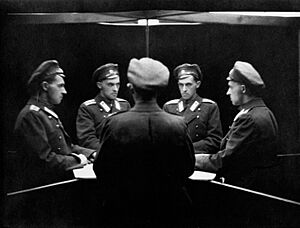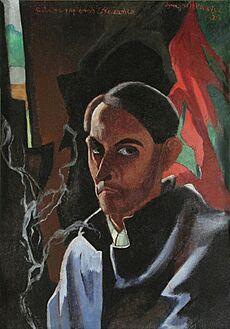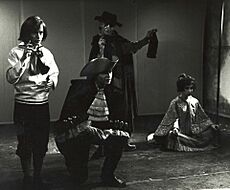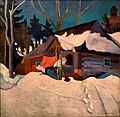Stanisław Ignacy Witkiewicz facts for kids
Quick facts for kids
Stanisław Ignacy Witkiewicz
|
|
|---|---|
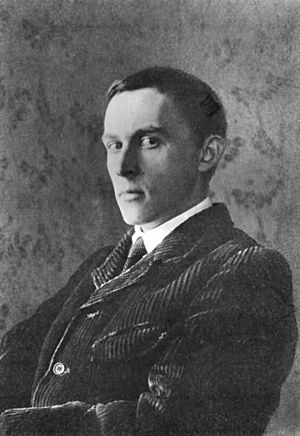
Stanisław Ignacy Witkiewicz, ca 1912
|
|
| Born | 24 February 1885 Warsaw, Congress Poland, Russian Empire |
| Died | 18 September 1939 (aged 54) Jeziory, Poland |
| Pen name | Witkacy |
| Occupation | Writer, painter, dramatist, philosopher, photographer |
| Alma mater | Kraków Academy of Fine Arts |
| Notable works |
|
| Spouse | Jadwiga Unrug, m.1923 |
| Partner | Jadwiga Janczewska |
| Relatives | Father: Stanisław Witkiewicz Godmother: Helena Modjeska Father-in-law: Juliusz Kossak |
Stanisław Ignacy Witkiewicz (24 February 1885 – 18 September 1939), often called Witkacy, was a famous Polish artist. He was a writer, painter, philosopher, and photographer. He was active before World War I and during the time between the two World Wars in Poland.
Contents
Life and Early Years
Stanisław Ignacy Witkiewicz was born in Warsaw. His father, Stanisław Witkiewicz, was a painter and art critic. His mother was Maria Pietrzkiewicz Witkiewiczowa. Both his parents came from a region in Lithuania. His godmother was the well-known actress Helena Modrzejewska.
Witkacy grew up in Zakopane, a town in the mountains. His father believed that formal schooling was not good. So, Witkacy was taught at home. He was encouraged to develop his many talents in art and writing. Even though his father disagreed, he later studied at the Kraków Academy of Fine Arts. There he learned from famous painters like Józef Mehoffer.
Witkacy was good friends with the composer Karol Szymanowski. He was also friends with Bronisław Malinowski, a famous explorer and scientist.
Travels and War Experiences
In 1914, after a sad event in his life, Witkacy joined Malinowski on an adventure. He went as a photographer on a trip to Territory of Papua, a place far away. They traveled through Ceylon (now Sri Lanka) and Australia. This trip was cut short when World War I began.
Witkacy was a citizen of the Russian Empire at the time. After a disagreement with Malinowski in Australia, he went to St Petersburg in Russia. He joined the Imperial Russian Army as an officer. His father, who was very proud of Poland, was sad about this choice. He died in 1915 without seeing his son again.
In 1916, Witkacy was badly hurt in a battle in what is now Ukraine. He was sent back to St Petersburg. There, he saw the Russian Revolution happen. He later said that he developed his ideas about philosophy during a time of heavy fighting. He claimed he was even chosen as a leader for his army group during the Revolution. His later works often showed his worries about big social changes and invasions. He often used strange and funny language to show these fears.
Artistic Career and New Ideas
When Witkacy returned to Poland, he started making a living by painting portraits. He then entered a very creative time in his life. He wrote down his ideas in books like New Forms in Painting. He also wrote many plays during this time. Out of about forty plays he wrote, twenty-one still exist today. Only one of his plays, Jan Maciej Karol Hellcat, was popular when he was alive.
After 1925, he started using the name 'Witkacy'. He jokingly called his portrait painting business The S.I. Witkiewicz Portrait Painting Company. Its funny motto was: "The customer must always be satisfied." He offered different styles of portraits, from realistic ones to more expressionistic ones.
In the late 1920s, he started writing novels. His most important novel was Insatiability. This book talked about big ideas like world politics and philosophy. In 1935, he received an award for his novels from the Polish Academy of Literature.
During the 1930s, Witkacy continued to explore his interest in philosophy. He wrote a book called Concepts and Principles Implied by the Concept of Existence in 1935. He also finished his famous play, Szewcy, which was published after his death. He also helped new writers like Bruno Schulz.
Death and Legacy
In September 1939, Poland was invaded by Germany. Witkacy escaped with his friend Czesława Oknińska to a small town in eastern Poland called Jeziory. After hearing that the Soviet Union had also invaded Poland on September 17, 1939, Witkacy died on September 18. A film called Mystification (2010) playfully suggests that Witkacy faked his death.
Witkacy was not very well known when he died. But his fame grew after World War II. Outside of Poland, his work was seen as an early example of a style called "Theatre of the Absurd". This idea was discussed in a famous book by Martin Esslin in 1961.
Czesław Miłosz, a famous writer, wrote about Witkacy's novel Insatiability in his book The Captive Mind. The artist and theater director Tadeusz Kantor was inspired by Witkacy's ideas. Kantor helped bring many of Witkacy's plays back to life, first in Poland and then around the world.
Witkacy's paintings and drawings can be found in many museums. These include the National Museum, Warsaw and the National Museum, Kraków. His photographs are in places like the Metropolitan Museum of Art in New York.
After the war, the Polish government decided to move Witkacy's body to Zakopane for a special funeral. This happened, but no one was allowed to open the coffin. Years later, in 1994, the Polish Ministry of Culture decided to check the grave. Tests showed that the body was not Witkacy's, but an unknown woman's. This was a strange and unexpected twist, much like the "absurdist" ideas in his own works.
Works
Art and Philosophy Books
- Nowe formy w malarstwie (1919), which means New Forms in Painting.
- Szkice estetyczne (1922), meaning Aesthetic Sketches.
Novels
- 622 Upadki Bunga czyli demoniczna kobieta (1911), partly translated as The 622 Downfalls of Bungo or The Demonic Woman.
- Pożegnanie jesieni (1927), partly translated as Farewell to Autumn.
- Nienasycenie (1930), translated as Insatiability.
Plays
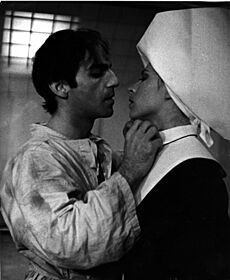
- Maciej Korbowa i Bellatrix (Maciej Korbowa and Bellatrix) (1918)
- Pragmatyści (1919) (The Pragmatists)
- Mister Price, czyli Bzik tropikalny (1920) (Mr Price, or Tropical Madness)
- Tumor Mózgowicz (1920) (Tumor Brainiowicz)
- Nowe wyzwolenie (1920) (The New Deliverance)
- Oni (1920) (They)
- Panna Tutli-Putli (1920) (Miss Tootli-Pootli)
- W małym dworku (1921) (Country House)
- Niepodległość trójkątów (1921) (The Independence of Triangles)
- Metafizyka dwugłowego cielęcia (1921) (Metaphysics of a Two-Headed Calf)
- Gyubal Wahazar, czyli Na przełęczach bezsensu (1921) (Gyubal Wahazar, or Along the Cliffs of the Absurd)
- Kurka Wodna (1921) (The Water Hen)
- Bezimienne dzieło (1921) (The Anonymous Work)
- Mątwa (1922) (The Cuttlefish)
- Nadobnisie i koczkodany, czyli Zielona pigułka (1922) (Dainty Shapes and Hairy Apes, or The Green Pill)
- Jan Maciej Karol Wścieklica (1922) (Jan Maciej Karol Hellcat)
- Wariat i zakonnica (1923) (The Madman and the Nun)
- Szalona lokomotywa (1923) (The Crazy Locomotive)
- Janulka, córka Fizdejki (1923) (Janulka, Daughter of Fizdejko)
- Matka (1924) (The Mother)
- Sonata Belzebuba (1925) (The Beelzebub Sonata)
- Szewcy (1931–34) (The Shoemakers)
Films by Witkacy
- Witkacy z Niną w Warszawie (1927): A comedy film starring Witkacy and his wife Jadwiga. It is a silent, black and white film, about 5 minutes long.
Other Writings
- Pojęcia i twierdzenia implikowane przez pojęcie istnienia (1935), meaning Concepts and Statements Implied by the Idea of Existence.
Images for kids
-
Composition
1922, National Museum, Kraków
Performances of Witkacy's Work
- The Crazy Locomotive (Szalona lokomotywa) was first performed in New York in 1977. It was directed by Des McAnuff. The play starred actors like Glenn Close.
- Two other plays, The Madman and the Nun (Wariat i zakonnica) and The Water Hen (Kurka Wodna), were also first performed in New York in 1979 and 1983. They were well-liked by critics and audiences.
- They (Oni) had its first British performance in London in 1984.
- The Shoemakers (Szewcy) was first performed in New York in 1987.
- The Madman and the Nun was also performed in Vermont and Boston in 1989. This show used both actors and life-sized puppets. Some of these puppets are now in the Witkacy Theatre in Zakopane, Poland.
- Witkacy's Tumor Brainiowicz was performed in New York by The Theatre of a Two-Headed Calf. This theater group was named after another one of Witkacy's plays. They also performed The Mother in 2003, which used puppets and video.
See also
 In Spanish: Stanisław Ignacy Witkiewicz para niños
In Spanish: Stanisław Ignacy Witkiewicz para niños
- History of philosophy in Poland
- Culture of Kraków
- List of Poles
- Mononymous persons



